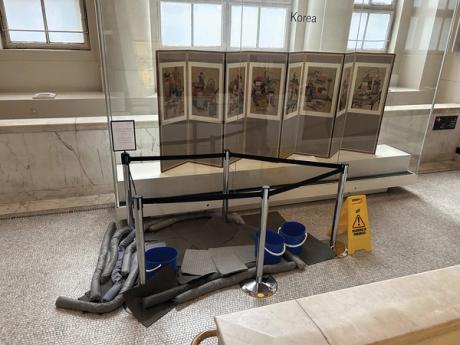
The British Museum is suffering an endless series of leaks from roofs that were built decades ago. The sight of buckets to catch drips is now commonplace and extra heaters are needed in some galleries to reduce humidity levels in winter. George Osborne, the chair of the museum’s trustees, admitted in a speech last November that for decades the building “has been patched up in a piecemeal way and by closing galleries when the rain comes in”.Osborne is pushing for an ambitious masterplan to upgrade the whole building, starting with the galleries in what is known as the Western Range—which houses mainly Greek and Assyrian antiquities on the ground floor. This includes the large room with the Parthenon Marbles, which have long been claimed by the Greeks.Although a project to build a new energy centre, to be partly funded with a controversial £50m donation from BP, was announced in December, progress on the masterplan for the galleries has slowed down as a result of the scandal over the theft of 2,000 Greek and Roman artefacts. The museum is without a permanent director to lead the project and fundraising will remain difficult until confidence in the institution is properly restored.Meanwhile, The Art Newspaper can report that emergency repairs are being made to roofs above galleries 17 (Greek Nereid monument), 19 (Athenian antiquities), 72 (Ancient Cyprus) and 92-94 (Japan).In a planning application to Camden Council last year, the museum stated that urgent work is required “to mitigate water ingress which is… putting the integrity of the building and the collection at risk of significant damage” and to tackle risks to “public safety”.A related problem concerns humidity levels. We can reveal that in December 2022 the important Assyrian reliefs were threatened by serious condensation, when unusual meteorological conditions led to moisture forming on the surface of the ninth-century BC sculptures. Emergency measures were required to dry them out and prevent any permanent damage. These reliefs are now particularly precious, because of the loss of similar panels in Iraq that were destroyed by Islamic State extremists in 2015.Dampness has also created problems for the museum’s central archive. This meant these invaluable historic records had to be moved in 2017 from its basement store and were put in temporary storage in the round reading room, which remains closed to visitors.A museum spokesperson points out that the museum is 270 years old “and we have been open about the fact it is in need of full-scale renovation”. The masterplan represents “one of the most significant cultural redevelopment projects undertaken anywhere in the world”.Many of the roofs around the Great Court of the 270-year-old building are in serious need of repair James/Adobe StockFunding will be a serious challenge in moving ahead. Although no figures or dates have been divulged, the total cost could well exceed £1bn for the entire building and take several decades.Plans for a new energy centreAn international architectural competition to transform the Western Range, which represents 7,500 square metres, a third of all the galleries, is due to be launched later this spring. Since the Bloomsbury building is listed for its architectural importance, any changes will require planning permission, but the hope is that it may still be possible to introduce some contemporary architecture and innovative gallery displays.Building work is due to start earlier on a new energy centre, adjacent to the Western Range. Among the issues that will need to be considered is dealing with any unexploded Second World War bombs. During that conflict the museum was severely damaged by six German bombs and others may have fallen undetected. A preliminary survey has revealed that there is a “medium risk” of unexploded ordnance in a few small specific areas of the museum, so proper procedures will be followed to avoid any risks while building work is underway.Meanwhile, the hunt goes on for a new director, following the resignation last August of Hartwig Fischer over the Greek and Roman theft. In September Mark Jones, a former director of the Victoria and Albert Museum, stepped in as interim director.The new directorship post was advertised, with a 26 January deadline for applications. Interviews will shortly be underway and an appointment will hopefully be made by April. The successful candidate is likely to have to give notice to leave their present job, so a successor will probably not be in post before the summer. Their main tasks will be to restore faith in the institution and press ahead with the early stages of the masterplan.


























